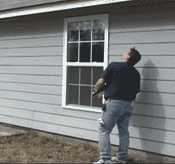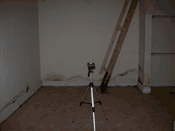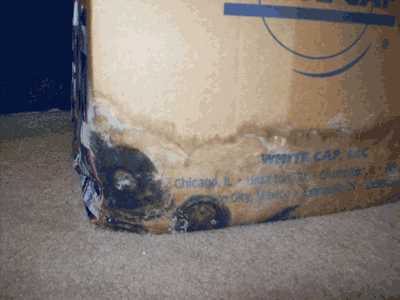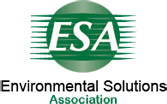Mold and Health Issues
Toxic mold causes severe health problems such as respiratory problems, asthma, flu like symptoms, headaches, chronic fatigue, nose bleeds, skin rashes and some pathogenic molds affect the central nervous system or suppress the immune system such as memory loss, Attention deficit disorder, and some cases brain damage in children and older adults.
Over half of the homes in the US have mold. Does yours?
How does mold cause health issues?
Exposure to molds occurs when people inhale mold spores. Mold spores are so small that they evade the protective mechanisms of the nose and upper respiratory tract. Although thousands of molds exist, only a few dozen are significant allergens. They aggravate or cause allergies and asthma, particularly, in children. The incidence of allergies and asthma has doubled in the last decade, which has been linked to the increase in air-borne molds in modern energy-efficient homes. One of five Americans suffers from allergies. The other common effects of exposure to molds include nasal stuffiness, eye irritation, wheezing, flu like symptoms, chronic sinus infections, rashes, nosebleeds, fever, shortness of breath, headaches, dizziness, inability to concentrate, fatigue, and respiratory infections. Some pathogenic molds effect the central nervous system or suppress the immune system.
Click here to read more about Mold Symptoms and Allergies
To schedule your inspection today, please call us
Office: (337) 786-4664
Be Safe – Get Your Home Inspected!
Don’t risk your family’s health. Get your home inspected by a professional, certified mold inspector today.
Call Russell D. Mayeaux or Dr. G. directly at (337) 786-4664 to set an appointment.
Before you rent or buy call The Mold Guy! (337) 786-4664
Before you pay high prices for Water and Mold damage
Call for an on site technical mold inspection which includes a full Thermal Imaging walk through.
Certified Mold Inspection
Mold Inspection can save you money from eliminating or reducing damage from mold. Mold can cause serious damage to your property and you may not even know it is happening. A certified mold inspector knows mold creates the most common indoor air quality complaint-from the smell of “mildew”
 Mold resting by a Certified Inspector may be warranted if you are experiencing any of the following:
Mold resting by a Certified Inspector may be warranted if you are experiencing any of the following:
- Is there musty smell in your building?
- Are there any visible signs of water damage?
- Has there ever been a leak in the roof or basement?
- Have there been plumbing leaks?
- Have you had a sink or sewer overflow?
Black Mold is one of the types of mold that is very toxic. This toxic mold fungus requires mold remediation.The most dangerous indoor molds are Alternaria, Aspergillus, Chaetomium, Cladosporium, Fusarium, Mucor, Penicillium, and Stachybotrys. Mold sampling and mold lab analysis are required to identify specific mold species.
Common Symptoms of Mold Exposure
The following are a list of some of the Mold Exposure Symptoms. You may have a mold issue if any of the residents of the building or home are experiencing adverse health effects such as:
- Nausea
- Sinus congestion
- Coughing
- Running Nose
- Sneezing
- Skin Rashes
- Flu Like Symptoms
- Headaches
- Restlessness
- Irritation of the eyes
 In addition to discovering the type and extent of a mold problem, a professional mold inspector will look for the source of your moisture intrusion. Moisture problems need to be identified and corrected as soon as possible because mold can start to grow within 24 to 48 hours after an intrusion. Since there are no guidelines or standards in the mold inspection and/or remediation industry, it is very important that you hire a mold professional to identify and correct any mold problems.
In addition to discovering the type and extent of a mold problem, a professional mold inspector will look for the source of your moisture intrusion. Moisture problems need to be identified and corrected as soon as possible because mold can start to grow within 24 to 48 hours after an intrusion. Since there are no guidelines or standards in the mold inspection and/or remediation industry, it is very important that you hire a mold professional to identify and correct any mold problems.
It is impossible to get rid of all mold spores indoors. Some mold spores will always be present in house dust and floating in the air.
Indoor mold growth can and should be prevented or controlled by controlling moisture indoors.The mold spores will not grow into mold colonies if there is insufficient moisture.If organic materials are wet for more than 24 hours mold will result.
The longer that mold grows, the more mold damage to the building.Mold grows by eating and destroying organic building materials and other cellulose-based materials such as carpeting, upholstery, and clothing.
 Cellulose is the main substance in the cell walls of plants (and thus of wood), and it is used in the manufacture of many organic building materials such as drywall, plasterboard, plywood substitutes, and ceiling tiles.
Cellulose is the main substance in the cell walls of plants (and thus of wood), and it is used in the manufacture of many organic building materials such as drywall, plasterboard, plywood substitutes, and ceiling tiles.
Mold can grow hidden and undetected inside wall and ceiling cavities; beneath wallpaper, paneling, and carpeting; and inside heating and cooling equipment and ducts, attics, crawl spaces, and basements.
Mold growth is often the result of a structural or construction defect, or of maintenance neglect, that allows moisture to enter the building, making a toxic mold building or toxic mold house.
Frequent causes of mold and where it grows best:
Basement flooding and water intrusion, or Closeness to a lake, river, or ocean
Clothes dryer exhausting into walls/attic
Condensation water problems
Construction defects/poor workmanship
Crawl space dirt and humidity
Dryer venting into walls or attic
Exhaust fans venting into walls or attic
Firewood indoors
Flooding
Lot grading downward to home
High indoor humidity [50 to 60% plus]
Humidifiers & vaporizers
Inadequate ventilation
Indoor plants
Overflow from tubs/showers/sinks/toilets
Landscaping like mulch & plant glut
Leaky roof
Venting lacking in kitchen/bathrooms
Sewage pipe leaks
Siding water leaks
Water supply pipe leaks
Mold issues and the litigation involved!!!
Mold issues and the litigation involved!!!
PITTSBURG — Tenants of an apartment complex here are suing their management company over claims that it failed to remove mold that made them sick.
About 30 residents of Portofino Apartments on Loveridge Circle are signing onto a lawsuit, said attorney Bob Levin, against management company Riverstone Residential Group, citing poor living conditions and retaliatory responses to complaints. Levin said he plans to file the suit “within the statutory period,” once he meets with all prospective plaintiffs.
The common thread among the tenants’ complaints is allegations of mold growing on walls, in carpet, and in windowsills and doorjambs. Other complaints include cockroach and rodent infestations, broken heating and air conditioning systems, and faulty smoke detectors.
Residents say their concerns have been ignored, and instead were met with eviction threats.
“I have investigators looking into other aspects of this,” said Levin, who is considering seeking class-action status. “I don’t know how far this thing’s going to go.”
Katie Fleischer, a representative for Riverstone, said the company had no comment.
Trina Henderson, who was the first Portofino resident to contact Levin, said she had been living at the complex for a month when the dizziness, nausea and breathing problems began this spring.
Though she already suffers from an autoimmune disease, Henderson said these symptoms were new. Soon, Henderson found what she believes to be the culprit: black mold around her windowsills, on the ceiling, and spreading into the carpet.
When management told Henderson in writing that they found “no infestation of mold/mildew” in her apartment, Levin arranged a mold inspection that confirmed Henderson’s suspicions: elevated levels of airborne mold, as well as surface mold.
The May 24 report, by Folsom’s Environmental Services, noted leaks from window sills and mold growing at the living room’s sliding glass door.
“The longer we’re staying in here, the sicker we’re getting,” said Henderson, who lived in the unit from February until last week with her 23-year-old son.
Now, other Portofino tenants, including Kim Carlson, have come forward saying they are sick from toxic mold. They say the management company has refused to fix it, and that their complaints have been met with retaliation.
Carlson said her infant grandson became sick after management failed to fix a roof leak, and she began finding mold growing on her walls behind furniture. She said the baby was hospitalized at Children’s Hospital Oakland for two months for a nervous system disorder, and that doctors suspect mold exposure as the cause.
An Environmental Services’ inspection of Carlson’s unit done June 4 found “visible mold growth” in the kitchen, bedrooms, bathrooms and living room.
After notifying management of the situation, Carlson said she was wrongfully evicted from the apartment. Carlson said she would have left on her own but couldn’t afford the expense.
She said she recently lost her job and home to foreclosure, and will be homeless when she leaves Portofino on July 18.
“People don’t care,” Carlson said. “They don’t want to help people like me.”
On www.complaintsboard.com, a former tenant of a Riverstone property in Walnut Creek complains of a similar situation in which he received what he perceived as a wrongful eviction notice after complaining of a mold problem. Internet research also turned up similar consumer complaints about Riverstone properties in Louisiana, North Carolina, Texas and Washington.
According to the Centers for Disease Control and Prevention, evidence has been found linking indoor mold exposure to respiratory problems in children and adults suffering from other ailments, such as autoimmune disorders and asthma.
According to city, state and county officials, tenants whose landlords won’t address mold infestations have little recourse other than legal action.
Pittsburg building official Curtis Smith, who inspected Henderson’s apartment at her request, said his department’s purview extends mainly to structural and building code issues.
“We just don’t get involved in mold,” Smith said. “We just don’t have the expertise.”
Contra Costa County hazardous materials specialist Melissa Hagen said landlords are responsible for repairing any water leak that causes mold to grow. If landlords aren’t responsive, Hagen said tenants can legally withhold rent to pay for the repairs, or can take them to court.
State Consumer Affairs spokeswoman Kim Brown said that because scientists differ on the health effects of mold exposure, it may be difficult for tenants to prove what has made them ill.
“I would say they had a legal battle ahead of them,” Brown said.
Now that she has moved out, Henderson said she wants to recoup her medical and moving expenses through the lawsuit, and prevent future tenants from having the same problems.
“My main goal,” she said, “is to make them clean these apartments up.”
Dan Rosenstrauch/Staff
Portofino Apartments resident Trina Henderson holds a report this month showing elevated mold levels in her apartment.
Our Commercial 2
Increased exposure to allergenic mold spores.
AUSTIN, Texas, July 12 (UPI)
Lots of rain and lots of summer humidity can increase exposure to allergenic mold spores — an important trigger of allergies, a U.S. allergist says.
Dr. Henry Legere of Greater Austin Allergy in Austin, Texas, says mold can be found inside and outside the home, but mold can be brought inside the home on skin or pets, clothing, shoes or indoor potted plants and once inside it needs only a food source, warm environment and moisture to grow.
Large infestations of mold can usually be seen — black stains or specks of black, white, orange, green and brown on surfaces — or smelled. However, mold can be INVISIBLE.
“Mold spores contain allergens, substances that some immune systems recognize as dangerous,” Legere says in a statement. “Exposure to mold can trigger allergic reactions such as nasal stuffiness, eye irritation, wheezing, coughing and hay fever-like symptoms.”
Mold can be found in basements, crawl spaces, near windows, under sinks, near leaky pipes, heavy vegetation, in piles of leaves and in grass.
BEFORE removal of mold, the most important step is first having the infested area tested, as different species of mold can create different level of mycotoxins, and improper removal or cleaning can cause a chain reaction therefore causing cross contamination throughout the rest of the dwelling.
The first step is to eliminate the moisture or water intrusion. Then have the testing performed to verify species of mold before cleaning, and then have a certified remediation specialist perform the removal following the NY City Remediation Guidelines.
For more information: Please contact me at any time.
Russell Mayeaux (the mold guy)
CMIA
Office:(337) 786-4664
New Inspection Services in Louisiana
Mold Inspection USA is servicing South, Central and North West Louisiana with our full range of services. All inspections are conducted through the eyes of science. All samples are sent to a Certified Lab.
Louisiana Mold Inspections
Protect your family because they are the most important people in your life!
Before you rent or buy a house be sure to call us for a mold inspection.
Not sure if you have mold or not?
A simple walk through utilizing a State-of-The-Art Thermal Imaging -Only $99.00
Know that your families health
is not at risk!
You can Contact Us anytime at the following numbers:
Office: (337)786-4664







